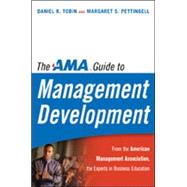
Daniel R. Tobin (Stamford, CT) is Vice President of Instructional Design and Development for the American Management Association (AMA) and has more than 30 years' experience as a corporate training director, consultant, writer, and speaker on corporate learning strategies.
Margaret S. Pettingell (Hillsborough, NJ) is is an instructional designer with AMA. She previously held positions with Novations Group, Accenture, and Decker Communications.
| Foreword | p. v |
| Introduction | p. 1 |
| Starting with the End in Mind | p. 7 |
| Competence: The Ability to Do Something Well | p. 27 |
| The AMA Management Development Competency Model: Knowing and Managing Yourself | p. 49 |
| The AMA Management Development Competency Model: Knowing and Managing Others | p. 77 |
| The AMA Management Development Competency Model: Knowing and Managing the Business | p. 117 |
| Selecting for Competence | p. 165 |
| Developing Employees | p. 177 |
| Management Development Beyond Training | p. 195 |
| The Role of the Manager/Employee Relationship | p. 211 |
| The Role of the Organizational Leadership | p. 227 |
| The Role of the Human Resources Group | p. 241 |
| The Role of the Training Group | p. 253 |
| The Future of Management Development | p. 267 |
| The AMA Management Development Competency Model | p. 277 |
| Endnotes | p. 323 |
| Index | p. 327 |
| Table of Contents provided by Ingram. All Rights Reserved. |
The New copy of this book will include any supplemental materials advertised. Please check the title of the book to determine if it should include any access cards, study guides, lab manuals, CDs, etc.
The Used, Rental and eBook copies of this book are not guaranteed to include any supplemental materials. Typically, only the book itself is included. This is true even if the title states it includes any access cards, study guides, lab manuals, CDs, etc.